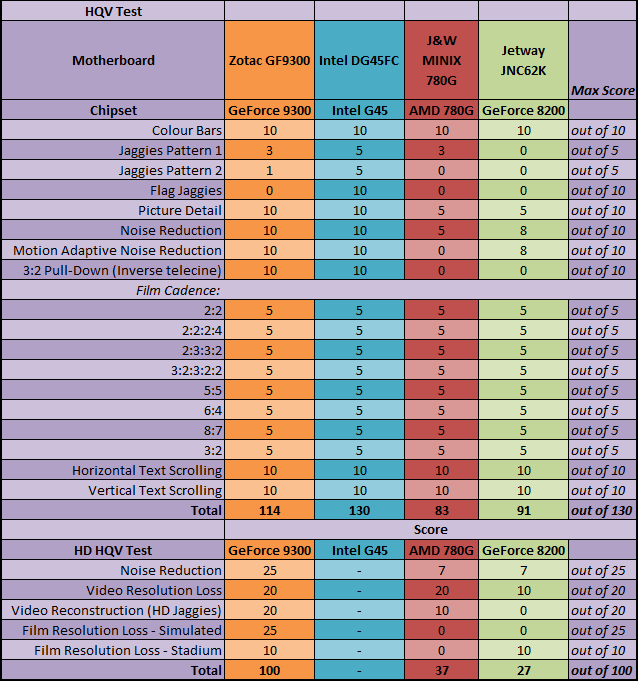Zotac GeForce 9300 (MCP7a) motherboard
October 15, 2008 | 14:06

HQV and HDHQV
Silicon Optix, makers of HQV and HD HQV, provides an industry standard benchmark for looking at video quality by providing tests the cover all areas of video processing playback: (motion adaptive) de-interlacing, noise reduction, 3:2 Pull-down detection (Inverse telecine), Film Cadence and Film Resolution manipulation.The tests are scored out of 130 and 100 for the HQV and HD HQV tests respectively, where a score of 130 and 100 in each case is considered "perfect."
We set the output at 1080p to test the video processing of the chipset, as opposed to the display. While we left the "performance settings" on auto, we did adjust the de-interlacing settings to find the best solution available from the drivers.
Unfortunately because our Intel G45 reference board lacks and IDE socket, we were unable to test HD HQV which we only have on HD DVD and our Toshiba HD DVD drive is IDE. Without an alternative disc or drive, and a SATA to IDE adapter not working, we were unable to complete the HD HQV tests for Intel G45 unfortunately.

HQV
There have been clear improvements with the GeForce 9300 and PureVideo HD, and the last GeForce 8200 we looked at, despite the fact the core shader count and core graphics performance should be the same. For the first test, the colour bars are displayed correctly without flicker, blur or banding and the gradient in the middle has a normal progression.Despite Nvidia claiming excellent deinterlacing performance, it's no better than the current AMD 780G solution. It still worked, and it was obvious that something was happening when we turned off deinterlacing, but Intel's ClearVideo solution is still the best we've seen to date. In comparison, the Intel board offers a far superior advanced de-interlacing option in PowerDVD and despite its lower shader power it gives a perfect result in all the deinterlacing tests.
The rest of the HQV tests were perfect - the picture detail was crisp with no over-sharpening (we left the sharpness at an Nvidia recommended 65 percent in the Nvidia Control Panel), the noise reduction worked very well at 50-60 percent again without over-sharpening. Whereas AMD has simply a fixed slider with three or four functions only available, or a tick box on or off, Nvidia offers a sliding percentage function for noise reduction that can be manually chosen.
Intel also does this in its drivers and even offers a greater degree of freedom than Nvidia - we found a value of ~68 offers optimum performance on G45. However in comparison the Nvidia driver layout is much more user friendly - Intel doesn't appear to have had a redesign in many years and it all looks very tacked on.
In the motion adapter noise reduction test the Nvidia solution has consistently been better than the AMD 780G, however in our opinion it's even slightly better than the previous GeForce 8200 - the picture quality precision is excellent and the noise reduction very good indeed without over-sharpening the image. 3:2 pulldown (inverse telecine) also works as expected and on the first run through too - the drivers needed very little time to pick up that the function was correctly needed.
All in all, it's really a very good score from Nvidia and even despite the Intel G45 getting a perfect score in HQV, all Nvidia needs to work on is its deinterlacing algorithms and it will match Intel's ClearVideo here.
HD HQV
In HD HQV the Nvidia GeForce 9300 really does excel in areas we've not seen before, and in our opinion it gets a perfect score. We were naturally dubious when Nvidia claimed this at the press briefing, but testing this against others side by side it's clearly better. While not an accurate representation of HD video like on Blu-ray or HD DVD, the test does give an indication of the capability of the graphics processor for other HD video.Having the noise reduction in a selectable percentage works perfectly here, as the footage is accurately and obviously noise reduced without being over-sharpened with very little adjustment in the Control Panel settings. The video resolution loss test works as expected with hardware deinterlacing enabled from the PowerDVD settings.
The HD Jaggies are actually removed here perfectly, unlike in the normal HQV test, and both film resolution loss tests looks great with a working inverse telecine on the stadium footage.
Addendum 26th October 2008: AMD has contacted us to inform bit-tech that the performance of the 780G is limited by using a HT 1.0 CPU. We were told that using HT 3.0 CPUs (AMD K10 architecture like a Phenom) will improve performance in HD HQV, so in our next HTPC motherboard test we plan to also test with one of these CPUs.

MSI MPG Velox 100R Chassis Review
October 14 2021 | 15:04








Want to comment? Please log in.